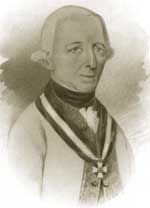Peter Vitus von Quasdanovitz

Østrigsk general.
- Lonato, 1796
Feldmarschall-Lieutenant and Commander of the Order of Maria Theresa. Quosdanovich joined the Warasdiner Hussars in 1752 at the age of 14 years, taking part in the Seven Years War with them , and reaching the rank of captain. by 1773, Quosdanovich was a lieutenant-colonel and commander of the Carlstädter Grenz Hussar regiment.
In the War of the Bavarian Succession of 1778-9 he distinguished himself as an especially bold member of the army. In the position of Schestowacz and Slavietin he had always thwarted the enemy's often attempted crossing of the Mette, and always thrown them back with losses. On 15 and 16 July, Quosdanovich carried out a successful attack on the enemy camp, and drove the enemy squads, whose vedettes he had overthrown, back behind their batteries. At Hradecz he delayed Wunsch's corps in its operations, overthrew Pitteri's grenadier battalion, and captured five 12pdr cannon. At Weisskirchen, on 26 November 1778, he steadfastly withstood the attack
that was carried out in view of the King of Prussia, and forced his opponents to retire after several hours of combat. He distinguished himself no less at Taubnitz, where he did not wait for the attack of the enemy, who was advancing in superior numbers, but attacked them himself, threw back their cavalry, and forced the infantry to move back behind their guns. For his feats of arms, Quosdanovich was promoted to colonel of the Slavonian Hussar regiment, and in the 13th promotion (of 19 May 1779) decorated with the Knight's Cross of the Order of Maria Theresa.
Quosdanovich performed new feats of arms in the following Turkish war of 1788. In this, he led the first column, consisting of 8 companies of infantry and 150 volunteers, in the attack on the enemy position at Berbir. The enemy, attacked in the rear, put up a desperate resistance, and only evacuated the field after three attacks. Quosdanovich was by this time a General-Major, and took over the command of Alt Gradisca.
In the campaigns against France, he first commanded a brigade, then in 1792, having been promoted to Feldmarschall-Lieutenant, a division. Apart from other occasions, he especially distinguished himself in the decisive actions at Handschuhsheim on 24 September 1795. At that time, Quosdanovich commanded three brigades. With that of Bajalich he held Neuenheim and Handschuhsheim on the right bank of the Rhine, and Heidelberg. With Frölich's brigade, Kirchheim on the right bank of the Neckar, and occupied Wisloch with Karaczay's brigade. He was attacked in these positions by the far superior numbers of the divisions of Dufour and Ambert. He held his position with great courage, and inspired his troops with his personal courage to such resistance that the enemy was forced to withdraw completely, with a loss of over 1,000 dead. Eight guns with their harness were captured, their ammunition wagons, and much baggage. General Dufour was taken prisoner with 19 officers and 500 men. The consequences of this victorious action were considerable. Field-Marshal Clerfayt, the commander of the Army of the Lower Rhine, who was already threatened in the rear, and whose link with General der Cavallerie Count Wurmser, commander of the Army of the Upper Rhine, was already endangered, was able to link with Wurmser via Nidda and threaten Jourdan's line of retreat by a flank march. He was moreover also obliged to move back behind the Rhine. For his brilliant feat of arms at Handschuhsheim, Quosdanovich was, in the 35th promotion (2 October 1795), with the highest award from the chapter, decorated with the Cross of Commander of the Order of Maria Theresa.
Afterwards, Quosdanovich went to the Army in Italy, where, however, he had no fortune in his operations, and was beaten at Castiglione in August 1796. Although a very courageous soldier, he possessed no higher talent for field command, and age and frailty, which paralysed his activity, were joined to a lack of education, which an army commander cannot under any circumstances do without. He retired in February 1797, and died five years later, aged 64 years. Quosdanovich is cited everywhere as a baron, but though he was entitled to claim a barony by his decoration with the Cross of Commander of the Order of Maria Theresa, it does not appear from the archives that he had received the diploma. The Hungarian nobility received a Joseph Quosdanovich in 1791 from Emperor Leopold II." Wurzbach, C., von. Biographisches Lexikon des Kaiserthums Oesterreich, Vienna, 1856-91 vol 24, pp. 153-4.
Quasdanovitch
Peter Vitus von Quosdanovich